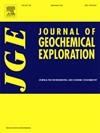Multistage hydrothermal fluids evolution and precipitation mechanism of the Hongshi Cu deposit in Eastern Tianshan, NW China: Insights from cathodoluminescence, fluid inclusions, trace elements of quartz and in situ S isotopes of sulfides
IF 3.4
2区 地球科学
Q1 GEOCHEMISTRY & GEOPHYSICS
引用次数: 0
Abstract
The Hongshi Cu deposit is located in the southeastern Kalatag district in Eastern Tianshan, northwest China. The Cu mineralization is mainly hosted by volcaniclastic rocks of the Daliugou Formation and structurally controlled by fracture zones. Comprehensive analyses of fluid inclusions, in situ sulfur isotopes, and trace elements in quartz were employed to unravel the evolution of ore fluids, identify the sources of ore-forming components, and refine the understanding of ore genesis. The ore formation at Hongshi could be divided into three hydrothermal stages, consisting of quartz-pyrite (stage I), quartz-sulfide (stage II), and quartz-calcite (stage III). Five hydrothermal quartz generations have been identified through cathodoluminescence (CL) imaging, including Q1–1 and Q1–2 from stage I, Q2–1 and Q2–2 from stage II, and Q3 from stage III. Aqueous fluid inclusions from stage I exhibit relatively high temperatures (208–313 °C) and moderate salinities (3.1–9.3 wt% NaCl equiv.). Microthermobarometry results confine the quartz−sulfide veins to temperatures ranging from 151 to 243 °C and salinities of 1.9–7.2 wt% NaCl equiv. Quartz−calcite veins formed from low−temperature and low−salinity fluids, with homogenization temperatures and salinities of 123–168 °C and 0.53–3.23 wt% NaCl equiv., respectively. Based on in situ trace element analysis of the five quartz generations, the Ti concentrations for the ore fluids are 33.20–129.00 ppm (mean = 79.88 ppm), 5.12–27.30 ppm (mean = 16.54 ppm), 1.01–17.20 ppm (mean = 6.96 ppm), 1.48–9.98 ppm (mean = 5.15 ppm), and 14.70–52.70 ppm (mean = 24.19 ppm). The Al concentrations for the ore fluids are 2058–4889 ppm (mean = 3562 ppm), 150–1916 ppm (mean = 1109 ppm), 133–2470 ppm (mean = 926 ppm), 32–174 ppm (mean = 82 ppm), and 686–2296 ppm (mean = 1555 ppm). The trace element data and trends across the five generations of quartz are optimally interpreted as indicative of magmatically derived ore fluids that were subsequently diluted by meteoric water, resulting in mineralization. Fluid mixing is regarded as the primary mechanism responsible for Cu precipitation at Hongshi. Sulfides of pyrite, chalcopyrite, and sphalerite yield δ34SV-CDT values from −0.21 to +6.21 ‰, with no discernible systematic variations among the various paragenetic stages. The data presented herein support a magmatic origin for the Hongshi deposit. This study clarifies the role of fluid dilution in initiating Cu deposition and offers insights into the genesis of Cu-polymetallic epithermal deposits within the Eastern Tianshan region.

东天山红石铜矿多期热液演化及沉积机制——来自阴极发光、流体包裹体、石英微量元素和硫化物原位S同位素的启示
红石铜矿位于中国西北部东天山克拉塔格地区东南部。铜成矿主要赋存于大柳沟组火山碎屑岩中,受断裂带控制。通过流体包裹体、原位硫同位素和石英微量元素的综合分析,揭示了成矿流体的演化,确定了成矿组分的来源,完善了对矿床成因的认识。红石矿床可划分为石英-黄铁矿(ⅰ期)、石英-硫化物(ⅱ期)和石英-方解石(ⅲ期)三个热液期。通过阴极发光(CL)成像鉴定出5代热液石英,其中ⅰ期为Q1-1、Q1-2代,ⅱ期为Q2-1、Q2-2代,ⅲ期为Q3代。第一阶段的含水流体包裹体表现出相对较高的温度(208-313℃)和中等盐度(3.1-9.3 wt% NaCl当量)。石英-方解石脉由低温和低盐度流体形成,均一温度和均一盐度分别为123-168℃和0.53-3.23 wt% NaCl当量。根据5代石英的原位微量元素分析,矿石流体中Ti的浓度分别为33.20 ~ 129.00 ppm(平均79.88 ppm)、5.12 ~ 27.30 ppm(平均16.54 ppm)、1.01 ~ 17.20 ppm(平均6.96 ppm)、1.48 ~ 9.98 ppm(平均5.15 ppm)和14.70 ~ 52.70 ppm(平均24.19 ppm)。矿石流体中的铝浓度为2058-4889 ppm(平均= 3562 ppm)、150-1916 ppm(平均= 1109 ppm)、133-2470 ppm(平均= 926 ppm)、32-174 ppm(平均= 82 ppm)和686-2296 ppm(平均= 1555 ppm)。五代石英的微量元素数据和趋势被最佳地解释为岩浆衍生的矿石流体,这些流体随后被大气水稀释,导致成矿。流体混合被认为是红石铜沉淀的主要机制。黄铁矿、黄铜矿和闪锌矿的硫化物δ34SV-CDT值在−0.21 ~ +6.21‰之间,各共生阶段的硫化物δ34SV-CDT值无明显的系统变化。本文提供的资料支持红石矿床的岩浆成因。本研究阐明了流体稀释对Cu沉积的启动作用,为研究东天山地区铜多金属浅成热液矿床的成因提供了新的思路。
本文章由计算机程序翻译,如有差异,请以英文原文为准。
求助全文
约1分钟内获得全文
求助全文
来源期刊

Journal of Geochemical Exploration
地学-地球化学与地球物理
CiteScore
7.40
自引率
7.70%
发文量
148
审稿时长
8.1 months
期刊介绍:
Journal of Geochemical Exploration is mostly dedicated to publication of original studies in exploration and environmental geochemistry and related topics.
Contributions considered of prevalent interest for the journal include researches based on the application of innovative methods to:
define the genesis and the evolution of mineral deposits including transfer of elements in large-scale mineralized areas.
analyze complex systems at the boundaries between bio-geochemistry, metal transport and mineral accumulation.
evaluate effects of historical mining activities on the surface environment.
trace pollutant sources and define their fate and transport models in the near-surface and surface environments involving solid, fluid and aerial matrices.
assess and quantify natural and technogenic radioactivity in the environment.
determine geochemical anomalies and set baseline reference values using compositional data analysis, multivariate statistics and geo-spatial analysis.
assess the impacts of anthropogenic contamination on ecosystems and human health at local and regional scale to prioritize and classify risks through deterministic and stochastic approaches.
Papers dedicated to the presentation of newly developed methods in analytical geochemistry to be applied in the field or in laboratory are also within the topics of interest for the journal.
 求助内容:
求助内容: 应助结果提醒方式:
应助结果提醒方式:


